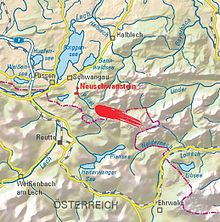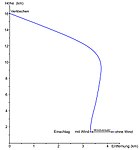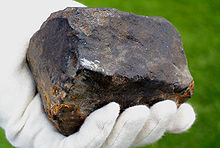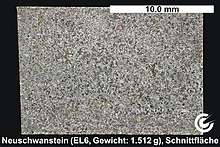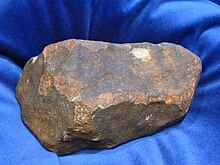Neuschwanstein (meteorite)
| Neuschwanstein (meteorite) | |
|---|---|
| Official meteorite names | Neuschwanstein I, II and III |
| Locality | in the forest southeast of Hohenschwangau , 3 fragments |
| Fall time | April 6, 2002, 10:20:18 PM CEST |
| description | Weight: 1750 grams; 1625 grams; 2842 grams; Enstatite chondrite (EL6); Density: 3.595 g / cm 3 (Neuschwanstein I) |
| origin | Asteroid (4486) Mithra ? |
| collection | Rieskrater Museum , Nördlingen u. a. |
| authenticity | for sure |
The meteorite Neuschwanstein reached the earth on April 6, 2002 at 10:20:18 pm CEST near Füssen in Bavaria near Neuschwanstein Castle in the German-Austrian border area ( Ammergau Alps ).
The original meteoroid shattered into several fragments at a height of about 22 kilometers above the ground, which fell over an area of several square kilometers. So far, three of these fragments with a total mass of around six kilograms have been recovered. Neuschwanstein was classified as enstatite chondrite (type EL6), an extremely rare group within the stone meteorites . It is considered to be the first meteorite in Germany (and the fourth worldwide) that could be found on the basis of simultaneous photographic recordings.
Meteorite fall and record
The 90.6 kilometer long trail of the meteor within the earth's atmosphere began at an altitude of around 85 kilometers above Innsbruck with an entry angle of about 49 degrees to the horizontal and ended 16.04 kilometers above the earth's surface. Shortly before, at a height of about 22 kilometers, at the so-called inhibition point , the bolide burst and the fragments that had glowed after a short time went into the so-called dark flight phase , where they fell down without any further glowing phenomena.
The entry speed of 20.95 kilometers per second of the celestial body weighing up to 500 kilograms into the earth's atmosphere was slowed down by air friction. During the transition to the dark flight phase, it was still around 2.4 kilometers per second. After another five seconds, the fragments fell below the speed of sound and went into free fall, which lasted about 108 seconds. The impact speed on the earth's surface was ultimately around 250 to 280 kilometers per hour. In the lower atmospheric layers ( troposphere ) the fragments were deflected by the wind against their original direction of flight.
The European Fireball Network received records of the case with several fireball stations, including Streitheim near Augsburg , Přimda ( Czech Republic ) and Gahberg ( Austria ). With the help of this stereo recording , the trajectory of Neuschwanstein could be reconstructed fairly precisely by triangulation taking into account the wind conditions at that time. However, since the trajectories of the individual fragments could not be specified more precisely, a decline area of several square kilometers (so-called distribution ellipse ) in the German-Austrian border area between Füssen and Garmisch-Partenkirchen was determined.
Media coverage and eyewitness reports
The sensation caused by the fall of this meteorite was remarkable. Concerned citizens across Bavaria reported the bright light phenomenon to the police by telephone. Hundreds of random observers also reported to the local newspapers and regional radio and television stations, so that the bolide received a corresponding response in the media. In southern Bavaria, especially in the greater Garmisch-Partenkirchen area, a loud "drumming" and rumble of thunder as well as the trembling of window panes were perceived. More than 200 kilometers away, shadows from trees could be seen through the brightness of the meteor in the middle of the night. Eyewitnesses compared the apparent brightness of the meteor with that of the full moon (up to −13 mag). The later evaluation of the photographs of the European fireball network showed that the meteor was even brighter with up to −17.2 mag. After the bolide burst about 22 kilometers above the ground, about half a dozen yellow-orange afterglow fragments rained down in trajectories. The total duration of the drama was about six seconds. When it became clear after a few weeks in which region the meteorite fragments had fallen, a rush of meteorite hunters began in the area around Neuschwanstein, Füssen and the Ammer Mountains.
Analysis of the heliocentric orbit
The orbit of the meteoroid Neuschwanstein (European network designation: EN060402) around the sun could be calculated back from the data recorded by the European fireball network . It turned out that it coincided almost exactly with the orbit of the meteoroid Přibram (EN070459), the fall of which had already been recorded on April 7, 1959 in what was then Czechoslovakia . It is therefore obvious that both meteorites could have come from the same mother body. However, Přibram is a common chondrite (type H5). A comparison of the cosmogenic isotopes of the two stones shows that Neuschwanstein is 48 million years old, while that of Přibram is 12 million years. A common mother body would have to be of a heterogeneous nature. At best, it could be a "rubble pile" held together by gravity , which was blown up by a collision with another celestial body. A clear assignment to an original asteroid is difficult. The orbits of several earth orbit cruisers come very close to the meteorite orbits of Neuschwanstein and Přibram, among others from the minor planets 2002 EU11 , 2002 QG46 and (4486) Mithra , which could also be a rubble pile .
Finds

The expert expedition by the German Aerospace Center (DLR) on May 1, 2002, which was initially delayed by the wintry weather, was concerned with the potential main fragment of the meteorite (estimated at around seven kilograms at the time). This could not be found despite an intensive search. It was suspected on the southern slope of the Hohen Straussberg near Neuschwanstein or on the northern flank of the Ochsenälpeleskopf . Overall, the DLR estimated the original total mass of the meteoroid at around 300 kilograms, of which around 20 kilograms would ultimately have reached the ground.
Neuschwanstein I
After a week-long search in the target area, the two Brandenburg amateur astronomers Nadin Bukow and Thomas Grau finally made their first find on July 14, 2002: A 1750 gram fragment of the meteorite was only about two kilometers from the calculated landing point of the main fragment and only 400 meters to the side of the calculated one Trajectory of the meteor on the western flank of the Ochsenälpeleskopf (coordinates of the location: 47 ° 31 ′ 30 ″ N , 10 ° 48 ′ 30 ″ E , 1650 m above sea level, rounded values). The fragment was probably smashed into a thick blanket of snow at a higher location and only rolled downhill as the snow melted until it was later found. It was named "Neuschwanstein" because of its proximity to the famous castle .
Neuschwanstein II
On May 27, 2003, another fragment was discovered by two meteorite hunters from Upper Bavaria on the northern flank of the Ochsenälpeleskopf (coordinates: 47 ° 32 ′ 0 ″ N , 10 ° 48 ′ 0 ″ E , 1491 m above sea level, rounded values), after they had already spent several weeks searching. The find, about the size of a fist, weighed 1625 grams. It probably hit the surface of the earth at high speed (around 250 km / h) and penetrated the forest floor. The finders had to retrieve it from a five centimeter deep hollow. Since the fragment had been stuck in the damp mountain forest floor for over a year, it showed signs of corrosion (rust spots).
Neuschwanstein III
Almost exactly one month later, on June 29, 2003, the last and, at 2842 grams, the largest meteorite fragment to date was recovered. It was located on a steep scree slope on the northern flank of Altenberg in the Austrian Tyrol (coordinates: 47 ° 31 ′ 0 ″ N , 10 ° 49 ′ 0 ″ E , 1631 m above sea level, rounded values). This fragment is also likely to have been carried down the valley during the snowmelt. A German physicist had determined its location using his own calculations and computer simulations . A form factor when calculating the wind drift during the dark flight phase was incorrectly assessed in the first analyzes by the DLR. After evaluating the first two finds, however, this was corrected, which after new model calculations led to the find of Neuschwanstein III .
It is now assumed that far less material has reached the ground than originally assumed, and Neuschwanstein III is considered to be the main mass of the meteorite. More meteorite fragments very likely exist. But in view of the fact that the affected area is for the most part very difficult to access, sometimes only with danger to life, is exposed to severe erosion and will be overgrown by plants within several vegetation periods, it seems unlikely that these will be discovered in the future.
Material analysis
The Neuschwanstein I meteorite fragment was chemically and petrologically examined in September 2002 at the Max Planck Institute for Chemistry in Mainz and at the Institute for Planetology in Münster . For this purpose, a total of 45 grams of material was separated. Accordingly, the three Neuschwanstein fragments belong to the group of enstatite chondrites (type EL6), a very rare group of stone meteorites ( chondrites ).
Among other things, the following minerals were detected:
- very high content of solid iron (28.6 wt.%)
- the silicate mineral enstatite (Mg 2 [Si 2 O 6 ])
- Plagioclase
- the extremely rare mineral sinoite (Si 2 N 2 O)
- graphite
- Writerite ((Fe, Ni, Cr) 3 P)
- Troilit (FeS)
- Oldhamite ((Ca, Mg, Fe, Mn) S)
- Daubréelith (Fe 2+ Cr 3+ 2 S 4 )
- Alabandin (α-MnS)
- Silicon dioxide (SiO 2 )
At the Max Planck Institute for Nuclear Physics in Heidelberg , measurements of natural radioactivity were carried out on all three fragments. Based on the content of cosmogenic radioisotopes , e.g. B. 7 Be ( half-life : approx. 53 days), 22 Na , 26 Al , 54 Mn and 57 Co could be concluded on the actual extraterrestrial origin of the finds. Measurements of the levels of purely terrestrial radioisotopes (e.g. 137 Cs , released during the Chernobyl nuclear disaster ) to which the meteorite fragments had been exposed since their fall also showed that they were fragments of the meteorite that fell in April 2002. Thus, for the first time in Germany, a meteorite could be recovered with the help of photographic recordings and model calculations .
Legal situation and whereabouts of the finds
The Free State of Bavaria claimed co-ownership of the two pieces Neuschwanstein I and Neuschwanstein II found in Germany by classifying them as treasure under German law ( Section 984 of the German Civil Code ). Finally, out of court agreements were reached: Bavaria bought the finders of Neuschwanstein I their finder half. In this way, the piece was completely preserved and has been on view in the Rieskrater Museum in Nördlingen since July 2003 .
The finder's share of the Neuschwanstein II fragment, however, could not be bought due to a lack of money and interest on the part of the Free State. As a result, the meteorite actually had to be divided in February 2004, whereby it was irrevocably destroyed in its entirety. The finders subsequently shared their half and sold samples to museums, institutions and private collections. The other half of Neuschwanstein II is in the possession of the Mineralogical State Collection in Munich and is inaccessible to the public, as it is only available for research purposes.
An unusual legal dispute broke out over the third meteorite find called Neuschwanstein III : The Austrian municipality of Reutte in Tyrol claimed ownership of the find, as the site was located on its territory, and filed a lawsuit with the Augsburg Regional Court for the surrender of the meteorite. The German court dismissed the lawsuit on June 6, 2007, applying Austrian law: the find was not a treasure , but an abandoned item . Nor is it a so-called increase in which the municipality automatically has a claim to ownership. With this, all property rights were granted to the finder in the first instance. The mayor of Reutte then appealed against this decision to the Munich Higher Regional Court . In January 2008, both parties agreed on a settlement, under which the finder of Neuschwanstein III made a compensation payment to Reutte and assumed the court costs. In return, he was able to keep the meteorite fragment, the value of which was estimated at around 200,000 to 300,000 euros.
Up to now (beginning of 2012) no final agreement has been reached with the finder about when and under what conditions Neuschwanstein III should be made accessible to the public. Allegedly negotiations are in progress about the sale to the Natural History Museum Vienna .
From March 28, 2012 to September 23, 2012 Neuschwanstein I , parts of Neuschwanstein II and also Neuschwanstein III were exhibited on the occasion of the 10th anniversary of the fall in the Rieskrater Museum in Nördlingen.
In very few countries there are legal regulations on meteorite finds. It is of crucial importance whether a meteorite is found on private property or in publicly accessible terrain, as was the case with Neuschwanstein . In Germany, in accordance with Section 984 of the German Civil Code ( BGB ), the finder initially has joint ownership of the meteorite ( Hadrian division ), assuming that the rules for finding treasures are applied analogously. With the exception of Bavaria, the treasure shelf applies in all federal states , according to which an object of particular scientific or cultural importance automatically and completely becomes the property of the state when it is found, regardless of whether it is found on private property or public property. In such a case, finders and property owners get nothing. Occasionally, however, they also receive compensation or a reward. Only Bavaria does not have such a treasure shelf and regulates according to the BGB. It is noteworthy that the Neuschwanstein meteorites were ascribed a considerable financial value primarily because of their enormous scientific importance and their rare material, but also because of their echo in the media. In this respect, fragments I and II were classified as "treasure-like" according to an expert report by the Bavarian Ministry of Science, although they did not fully meet this definition according to § 984 BGB, as they neither had a previous owner nor had been hidden for a long time.
The situation under Austrian law is similarly unclear. There it is allowed to collect minerals in the wild, provided that no recovery equipment is used.
See also
literature
- R. Hochleitner, D. Heinlein: Neuschwanstein, the meteorite from the Bavarian Alps . Ed .: Kulturstiftung der Länder, State Natural Science Collections of Bavaria. Munich 2003, ISBN 3-89937-040-6 .
- Dieter Heinlein: The fireball from April 6, 2002 and the sensational meteorite fall “Neuschwanstein” . Ed .: Dieter Heinlein. 1st edition. Augsburg 2004.
- A. Nordmeyer, J. Kassid: Who Owns the Stranded Meteorite? Extraterrestrial objects and the German property system . In: Ad Legendum . tape 1/2011 , January 2011, ISSN 1614-614X , p. 30-37 .
- Thorsten Süß: Of meteorites, skeletons and other treasures . In: JURA . 2011, p. 332-335 .
- Bavarian State Office for the Environment (Ed.): Out of this world - Bavaria's Meteorite . 1st edition. 2012, ISBN 978-3-936385-92-2 .
Web links
- The European fireball network. In: DLR - Institute for Planetary Research. Retrieved January 3, 2012 .
- The Neuschwanstein Meteorite. In: Bavarian Meteorite Laboratory (Dieter Heinlein). Retrieved January 3, 2012 .
- Final judgment of the Augsburg Regional Court in the Neuschwanstein III dispute, file number: 8 O 1758/06. (PDF; 119 kB) Retrieved January 3, 2012 . - abridged and commented version
- § 958 BGB - Acquisition of ownership of movable, abandoned property
- Neuschwanstein meteorite. youtube.com, accessed January 3, 2012 . - Well-known video of theNeuschwansteinmeteoritefall(surveillance camera of a feeding place)
- The litigation over the meteorite is over. In: Augsburger Allgemeine. Retrieved January 3, 2012 . - with a picture of theNeuschwanstein IIIfragmentand its finder
- Review by Dr. Klaus Graf, historian at the University of Freiburg - Ralf Fischer zu Cramburg: The treasure shelf. The magisterial claim to ownership of treasure finds in German law. In: Virtual Library Museums. Retrieved January 5, 2012 .
- Entry dynamics and acoustics / infrasonic / seismic analysis for the Neuschwanstein meteorite fall. (PDF; 4.1 MB) In: DO REVELLE, PG BROWN, and P. SPURN ›. Retrieved October 14, 2013 .
- Post from space - In search of meteorites Report on Thomas Grau, the discoverer of the Neuschwanstein meteorite. Retrieved September 15, 2014.
Individual evidence
- ↑ a b Florian Schweidler: The Bolide from April 6, 2002 . In: Stars and Space . tape 8 , August 2002, p. 52 .
- ↑ Dieter Heinlein: The fireball from April 6, 2002 and the sensational meteorite fall "Neuschwanstein" . Ed .: Dieter Heinlein. 1st edition. Augsburg 2004, p. 7 .
- ↑ Dieter Heinlein: The fireball from April 6, 2002 and the sensational meteorite fall "Neuschwanstein" . Ed .: Dieter Heinlein. 1st edition. Augsburg 2004, p. 4-5 .
- ↑ Pavel Spurný, D. Heinlein, J. Oberst: The atmospheric trajectory and heliocentric orbit of the Neuschwanstein meteorite fall on April 6, 2002 . In: ESA Publications Division (Ed.): Proceedings of Asteroids, Comets, Meteors - ACM 2002 . 2002, ISBN 92-9092-810-7 , pp. 137-140 , bibcode : 2002ESASP.500..137S .
- ↑ Hans Zekl: Neuschwanstein and Příbram: two unequal brothers. astronews.com, May 13, 2003, accessed January 3, 2012 .
- ↑ Dieter Heinlein: The fireball from April 6, 2002 and the sensational meteorite fall "Neuschwanstein" . Ed .: Dieter Heinlein. 1st edition. Augsburg 2004, p. 29 ff .
- ^ Meteor Neuschwanstein. (No longer available online.) In: DLR - Institute for Planetary Research. Archived from the original on August 4, 2012 ; Retrieved January 3, 2012 .
- ^ Jürgen Oberst, D. Heinlein, U. Köhler, P. Spurný: The multiple meteorite fall of Neuschwanstein: Circumstances of the event and meteorite search campaigns . In: Meteoritics & Planetary Science . tape 39 , no. 10 , 2004, p. 1627–1641 , bibcode : 2004M & PS ... 39.1627O .
- ^ Pavel Spurný, J. Oberst, D. Heinlein: Photographic observations of Neuschwanstein, a second meteorite from the orbit of the Příbram chondrite . In: Nature . tape 423 , no. 6936 , 2003, p. 151–153 , bibcode : 2003Natur.423..151S .
- ↑ Unknown author: Pseudo-relationship in the asteroid family . In: MaxPlanckResearch . tape 4 , 2002, p. 16–17 ( mpg.de ( memento from June 16, 2013 in the Internet Archive ) [PDF; accessed January 3, 2012]).
- ↑ Dieter Heinlein: The fireball from April 6, 2002 and the sensational meteorite fall "Neuschwanstein" . Ed .: Dieter Heinlein. 1st edition. Augsburg 2004, p. 14-15 .
- ↑ Neuschwanstein (case of April 6, 2002). In: ERFM. Retrieved April 9, 2014 .
- ↑ a b c Dieter Heinlein: The fireball from April 6, 2002 and the sensational meteorite fall "Neuschwanstein" . Ed .: Dieter Heinlein. 1st edition. Augsburg 2004, p. 17 .
- ^ Meteorite finds Neuschwanstein. (No longer available online.) In: DLR - Institute for Planetary Research. Archived from the original on July 28, 2012 ; Retrieved January 3, 2012 .
- ↑ Meteorite "Neuschwanstein 3" belongs to the finder. In: Spiegel online . July 6, 2007, accessed January 3, 2012 .
- ↑ Dieter Heinlein, Karl Wimmer: Neuschwanstein - A meteorite fall full of surprises . In: Stars and Space . tape 4 , April 2004, p. 40-44 .
- ↑ Dieter Heinlein: The fireball from April 6, 2002 and the sensational meteorite fall "Neuschwanstein" . Ed .: Dieter Heinlein. 1st edition. Augsburg 2004, p. 19 .
- ↑ Dieter Heinlein: The fireball from April 6, 2002 and the sensational meteorite fall "Neuschwanstein" . Ed .: Dieter Heinlein. 1st edition. Augsburg 2004, p. 29 .
- ↑ Thomas Witzke : Meteorites: Chondrites. Retrieved January 5, 2012 .
- ↑ Dieter Heinlein: The fireball from April 6, 2002 and the sensational meteorite fall "Neuschwanstein" . Ed .: Dieter Heinlein. 1st edition. Augsburg 2004, p. 28 .
- ↑ Kristine Faust: Who Owns Neuschwanstein? In: Aviso . No. 3 , 2003, ISSN 1432-6299 , p. 28-31 .
- ↑ a b Dieter Heinlein: The fireball from April 6, 2002 and the sensational meteorite fall "Neuschwanstein" . Ed .: Dieter Heinlein. 1st edition. Augsburg 2004, p. 27 .
- ↑ a b Austrians get away with nothing. A meteorite and its home. (No longer available online.) In: sueddeutsche.de . July 6, 2007, archived from the original on September 18, 2009 ; Retrieved January 3, 2012 . Info: The archive link was inserted automatically and has not yet been checked. Please check the original and archive link according to the instructions and then remove this notice.
- ↑ Property Law - Who Owns the Meteorite? (No longer available online.) Ewr-anwaelte.at, archived from the original on March 7, 2012 ; Retrieved January 3, 2012 . Info: The archive link was inserted automatically and has not yet been checked. Please check the original and archive link according to the instructions and then remove this notice.
- ↑ 10 years NeuschwanSsteine. rieskrater-museum.de, accessed on April 5, 2012 .
- ↑ A. Nordmeyer, J. Kassid: Who owns the stranded meteorite? Extraterrestrial objects and the German property system . In: Ad Legendum . tape 1/2011 , January 2011, ISSN 1614-614X , p. 30-37 .
- ↑ Dieter Heinlein: Legal dispute over sky rock . In: Stars and Space . tape 10 , October 2007, p. 19-20 .
